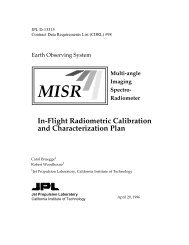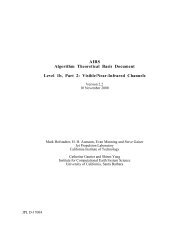Download - NASA's Earth Observing System
Download - NASA's Earth Observing System
Download - NASA's Earth Observing System
Create successful ePaper yourself
Turn your PDF publications into a flip-book with our unique Google optimized e-Paper software.
04<br />
The <strong>Earth</strong> Observer July - August 2012 Volume 24, Issue 4<br />
feature articles<br />
Aquarius: One Year After Launch<br />
Annette deCharon, Darling Marine Center, University of Maine, annette.decharon@maine.edu<br />
NASA’s Aquarius instrument<br />
was successfully<br />
launched from<br />
Vandenberg Air Force<br />
Base as part of the U.S./<br />
Argentina Aquarius/<br />
SAC-D observatory on<br />
June 10, 2011. The<br />
Aquarius instrument<br />
was designed primarily<br />
to measure global sea<br />
surface salinity.<br />
Introduction<br />
NASA’s Aquarius instrument was successfully launched from Vandenberg Air Force<br />
Base as part of the U.S./Argentina Aquarius/SAC-D 1 observatory on June 10, 2011.<br />
The Aquarius instrument was designed primarily to measure global sea surface salinity.<br />
The observatory “bus,” built by the Space Agency of Argentina, or Comisión Nacional<br />
de Actividades Espaciales (CONAE), also accommodates several other instruments<br />
developed by CONAE and its partners, including the French Space Agency (Centre<br />
National d’Études Spatiales), the Italian Space Agency (Agenzia Spaziale Italiana), and<br />
the Canadian Space Agency 2 .<br />
After a brief commissioning period, the Aquarius instrument was switched into mission<br />
mode on August 25, 2011. The “first-light” global image was released on September<br />
22, 2011, and featured two-and-half weeks of sea surface salinity data—the first<br />
such data ever collected by a NASA satellite. This map, shown in Figure 1, demonstrated<br />
Aquarius’ ability to detect large-scale salinity patterns clearly and with sharp<br />
contrast. About<br />
one month later, NASA<br />
Administrator Charles<br />
Bolden Jr. met with Argentine<br />
President Cristina<br />
Fernandez de Kirchner<br />
to witness the signing of a<br />
Framework Agreement on<br />
Cooperation in the Peaceful<br />
Use of Outer Space between<br />
the U.S. and Argentinian<br />
governments—see<br />
Figure 2.<br />
Figure 1. The first global map<br />
of the salinity of <strong>Earth</strong>’s ocean<br />
surface produced by NASA’s<br />
Aquarius instrument reveals a<br />
rich tapestry of global salinity<br />
patterns, demonstrating Aquarius’<br />
ability to resolve large-scale<br />
salinity distribution features<br />
clearly and with sharp contrast.<br />
Image credit: NASA/GSFC/<br />
JPL-Caltech<br />
The post-launch assessment<br />
review process for Aquarius<br />
was completed on December 1, 2011, marking both the beginning of the Aquarius<br />
science operations phase and transition of the Aquarius Project Office from NASA/<br />
Jet Propulsion Laboratory (JPL), to NASA’s Goddard Space Flight Center (GSFC).<br />
This event also triggered the “countdown clock” to reaching Aquarius’ principal scientific<br />
objective of achieving a monthly average global measurement error of less than<br />
0.2 practical salinity units (psu) at 150-km (93-mi) resolution—where salinity levels in<br />
the open ocean generally range from 32–37 psu—within one year. Equivalent to about<br />
one-eighth teaspoon of salt in a gallon of water, this accuracy presents a formidable yet<br />
exciting challenge for the Aquarius team and the oceanographic community at large.<br />
Science Team and Early Findings<br />
In 2009 NASA and CONAE conducted a joint solicitation and selection of scientific<br />
investigations and innovative application demonstration projects using Aquarius/SAC-<br />
D observations. NASA selected 15 projects, while CONAE and the Argentine Ministry<br />
of Science, Technology, and Innovative Production selected 15 projects, with participation<br />
of scientists from Chile and Brazil. An additional 10 proposals were selected<br />
from scientists in Italy and Japan to form a more diverse international science team.<br />
1<br />
SAC-D stands for Satélite de Aplicaciones Cientificas-D, meaning Satellite for Scientific<br />
Applications-D.<br />
2<br />
A story about collaborative efforts to build the Aquarius/SAC-D observatory at Argentina’s<br />
INVAP facility is featured in the Spring 2012 issue of NASA’s Ask magazine, available online at<br />
www.nasa.gov/offices/oce/appel/ask/issues/46.







